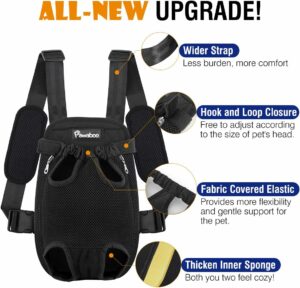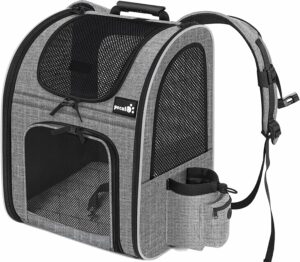
Pecute Pet Carrier Backpack, Cat Backpack Carrier with Breathable Mesh
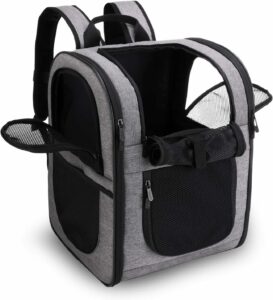
Apollo Walker Pet Carrier Backpack for Large/Small Cats and Dogs
Pros
- Price point may be higher compared to conventional pet gear.
- Availability might vary, depending on the region.
- Limited options in certain product categories.
- Emphasis on sustainability and eco-friendly practices.
- High-quality materials contribute to the longevity of products.
- Aesthetic appeal and stylish designs often mentioned as positives.
Cons
Sustainable Pet Travel Gear
Introduction
In the ever-evolving landscape of conscientious consumerism, sustainable living extends its reach to every facet of our daily lives, even how we care for our four-legged companions.
One area gaining prominence is the realm of “Sustainable Pet Travel Gear.”
As pet owners increasingly seek ways to reduce their ecological footprint, the demand for products that align with these principles has surged.
Provo Green Products embodies a beacon of trust in the realm of sustainable discoveries, offering choices that enhance your life and leave a positive mark on our planet.
Leveraging extensive expertise in manufacturing, construction, and various trades, we provide a solid foundation for sustainable living.
Our meticulous research process guarantees that our information about each product is precise and current, allowing you to make informed decisions.
Whether your interest lies in solar products, electric bikes, or other eco-friendly alternatives, our commitment to credibility ensures you have access to dependable insights, guiding your journey toward a more sustainable lifestyle.
Provo Green Products is your go-to destination for finding the right green products for your lifestyle.
Disclosure: We may earn a small commission if you click on one of our links. This will not affect the pricing of the product whatsoever.
Key Features of Sustainable Pet Travel Gear
Use of Recycled Materials:
- Incorporation of post-consumer recycled plastics for durability
- Reclaimed fabrics to minimize environmental impact
- Emphasis on reducing overall resource consumption through recycling initiatives
Biodegradable and Compostable Options:
- Introduction of products designed to decompose naturally
- Use of bioplastics and compostable materials for reduced landfill impact
- Commitment to minimizing long-term environmental consequences
Energy-Efficient Production Processes:
- Integration of eco-friendly manufacturing methods
- Reduced carbon footprint through energy-efficient facilities
- Emphasis on sustainable sourcing of raw materials
Durability and Longevity:
- Focus on creating products that withstand the rigors of travel
- Investment in quality craftsmanship to ensure prolonged usability
- Encouraging a buy-it-for-life mentality to minimize waste
Minimalistic and Functional Design:
- Streamlined and efficient designs to minimize excess material usage
- Multi-functional products to reduce the need for multiple items
- Aesthetic appeal coupled with practicality for a balanced user experience
These key features collectively define sustainable pet travel gear, embodying a commitment to environmental responsibility without compromising on the functionality and comfort that pet owners expect.
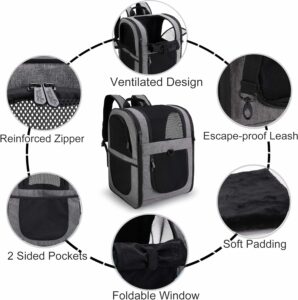
Popular Sustainable Materials in Pet Travel Gear
Hemp and Bamboo Fabrics:
- Hemp:
- Renowned for its strength and durability, hemp fibers are used in collars, leashes, and pet bedding.
- Cultivation of hemp requires minimal pesticides and water, making it an eco-friendly choice.
- Breathable and hypoallergenic properties ensure the comfort of pets during travel.
- Bamboo:
- A rapidly renewable resource, bamboo is employed for pet carriers, bowls, and feeding accessories.
- Biodegradable and compostable, bamboo products minimize environmental impact.
- Lightweight and strong, bamboo-based items are convenient for both pets and owners on the go.
Recycled Polyester and Nylon:
- Recycled Polyester:
- Derived from post-consumer plastic bottles, recycled polyester is used in pet harnesses and apparel.
- Reduces the demand for virgin polyester production, mitigating the environmental footprint.
- Durable and quick-drying, making it suitable for various weather conditions during travel.
- Recycled Nylon:
- Obtained from discarded fishing nets and industrial waste, recycled nylon is used in pet collars and carriers.
- Contributes to waste reduction in oceans while offering robustness and resistance to wear.
- High versatility and strength make it an ideal choice for products requiring durability.
Natural Rubber for Toys and Accessories:
- Derived from latex sap of rubber trees, natural rubber is utilized in pet toys, feeding mats, and grooming accessories.
- Biodegradable and non-toxic, ensuring the safety of pets during play.
- The elasticity and durability of natural rubber provide long-lasting entertainment for pets.
Eco-Friendly Dyes and Finishes:
- Utilization of plant-based and low-impact dyes for coloring pet accessories.
- Non-toxic and free from harmful chemicals, ensuring the safety of both pets and the environment.
- Sustainable finishes that do not compromise on aesthetics while meeting eco-friendly standards.
Cork and Recycled Rubber for Collars and Leashes:
- Cork:
- Lightweight and water-resistant, cork is employed in collars and leashes.
- Harvested from the bark of cork oak trees, promoting sustainability.
- Hypoallergenic and easy to clean, providing a practical option for pet travel.
- Recycled Rubber:
- Derived from discarded tires and industrial rubber waste, recycled rubber is used in collars and leashes.
- Reduces landfill waste while offering flexibility and strength.
- Resilient and weather-resistant, making it suitable for various travel conditions.
Exploring these materials not only showcases the innovation within sustainable pet travel gear but also emphasizes the industry’s commitment to reducing its environmental impact.
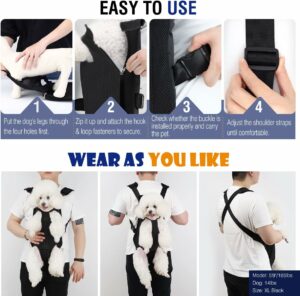
Best Practices for Sustainable Pet Travel
Reducing Carbon Footprint During Travel:
- Choose Sustainable Transportation:
- Opt for eco-friendly modes of transportation, such as trains or electric vehicles, when possible.
- Carpooling with other pet owners can help minimize the collective carbon footprint.
- Plan Efficient Routes:
- Plan travel routes to reduce mileage and overall fuel consumption.
- Consider exploring pet-friendly destinations closer to home to minimize travel impact.
- Offset Carbon Emissions:
- Contribute to carbon offset programs to compensate for unavoidable emissions.
- Support initiatives that invest in renewable energy or reforestation projects.
Choosing Environmentally Conscious Accommodation:
- Select Eco-Friendly Accommodations:
- Choose hotels or lodgings with recognized environmental certifications.
- Look for pet-friendly establishments that prioritize sustainable practices.
- Minimize Energy Consumption:
- Conserve energy by turning off lights, electronics, and air conditioning when not in use.
- Participate in hotel programs that encourage energy conservation.
Proper Waste Disposal on the Go:
- Pack Sustainable Pet Products:
- Choose biodegradable waste bags and environmentally friendly pet food packaging.
- Carry a reusable water bowl to reduce single-use plastic waste.
- Dispose of Waste Responsibly:
- Use designated pet waste disposal bins or carry the waste back to proper disposal facilities.
- Educate fellow pet owners on responsible waste disposal practices.
Supporting Pet-Friendly Eco-Initiatives:
- Choose Eco-Friendly Pet-Friendly Parks:
- Select parks and recreational areas that implement eco-friendly policies.
- Contribute to initiatives that aim to maintain the ecological balance of these spaces.
- Participate in Clean-Up Activities:
- Join local clean-up events during your travels to contribute positively to the environment.
- Encourage a sense of community among pet owners by organizing or participating in eco-conscious activities.
Educating Pet Owners on Sustainable Choices:
- Share Sustainable Travel Tips:
- Use your platform as a pet owner to share tips on sustainable pet travel.
- Encourage others to adopt eco-friendly practices through social media or local pet communities.
- Raise Awareness on Environmental Impact:
- Inform fellow pet owners about the environmental impact of traditional pet products.
- Advocate for the adoption of sustainable alternatives in pet care and travel.
By incorporating these best practices into your pet travel routine, you reduce your journeys’ ecological footprint and contribute to a broader movement towards sustainable and responsible pet ownership.
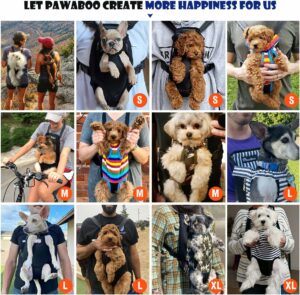
Additional Tips for Making Pet Travel More Sustainable
- DIY Travel Gear:
- Encourage pet owners to explore DIY options for sustainable pet accessories.
- Resources for creating homemade items like pet beds and toys with minimal environmental impact.
- Repurposing and Upcycling:
- Promote the repurposing of existing materials into pet travel gear.
- Creative ways to upcycle items, reducing the need for new purchases.
Conclusion
The realm of sustainable pet travel gear offers a transformative approach to responsible pet ownership.
Embracing sustainable alternatives not only enhances our pets’ travel experiences but contributes significantly to a harmonious coexistence with our planet.
Stay in Touch
I’am a dedicated entrepreneur with many years of experience and an integrity-driven individual who is highly motivated to succeed. Leveraging extensive expertise in manufacturing, construction, and various trades, we can provide a solid foundation for sustainable living. Our meticulous research process guarantees that our information about each product is precise and current, allowing you to make informed decisions. A deep understanding of business operations empowers me to consistently implement improvements that result in ongoing success. Visit site.

